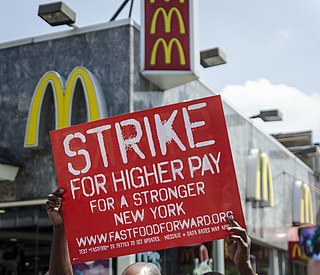| Part of a series on |
| Organised labour |
|---|
 |
In 1997, a number of labour strikes, labour disputes, and other industrial actions occurred.
| Part of a series on |
| Organised labour |
|---|
 |
In 1997, a number of labour strikes, labour disputes, and other industrial actions occurred.
A labour strike is a work stoppage caused by the mass refusal of employees to work. This can include wildcat strikes, which are done without union authorisation, and slowdown strikes, where workers reduce their productivity while still carrying out minimal working duties. It is usually a response to employee grievances, such as low pay or poor working conditions. Strikes can also occur to demonstrate solidarity with workers in other workplaces or pressure governments to change policies.
According to the State Conciliator of Norway, there was only one major strike in Norway in 1997. [62]
The US strike wave of 1945–1946 or great strike wave of 1946 were a series of massive post-war labor strikes after World War II from 1945 to 1946 in the United States spanning numerous industries including the motion picture and public utilities. In the year after V-J Day, more than five million American workers were involved in strikes, which lasted on average four times longer than those during the war. They were the largest strikes in American labor history. Other strikes occurred across the world including in Europe and colonial Africa.
The National Trades Union Congress (NTUC) spearheads the labour movement of Singapore, which represents almost a million workers in the country across more than 70 unions, affiliated associations and related organisations. Singapore runs on a tripartism model which aims to offers competitive advantages for the country by promoting economic competitiveness, harmonious government-labour-management relations and the overall progress of the nation.

The Fight for $15 is an American political movement advocating for the minimum wage to be raised to USD$15 per hour. The federal minimum wage was last set at $7.25 per hour in 2009. The movement has involved strikes by child care, home healthcare, airport, gas station, convenience store, and fast food workers for increased wages and the right to form a labor union. The "Fight for $15" movement started in 2012, in response to workers' inability to cover their costs on such a low salary, as well as the stressful work conditions of many of the service jobs which pay the minimum wage.
In 1982, a number of labour strikes, labour disputes, and other industrial actions occurred.
In 1983, a number of labour strikes, labour disputes, and other industrial actions occurred.
In 1985, a number of labour strikes, labour disputes, and other industrial actions occurred.
In 1987, a number of labour strikes, labour disputes, and other industrial actions occurred.
In 1988, a number of labour strikes, labour disputes, and other industrial actions occurred.
In 1996, a number of labour strikes, labour disputes, and other industrial actions occurred.
In 2000, a number of labour strikes, labour disputes, and other industrial actions occurred.
In 1978, a number of labour strikes, labour disputes, and other industrial actions occurred.
In 1998, a number of labour strikes, labour disputes, and other industrial actions occurred.
In 1999, a number of labour strikes, labour disputes, and other industrial actions occurred.
In 1995, a number of labour strikes, labour disputes, and other industrial actions occurred.
A number of labour strikes, labour disputes, and other industrial actions occurred in 1991.